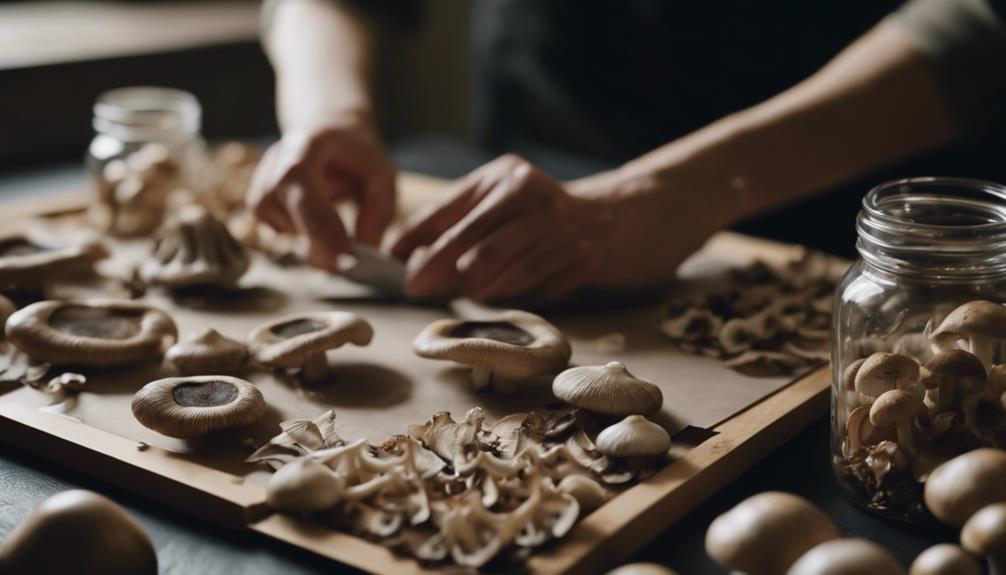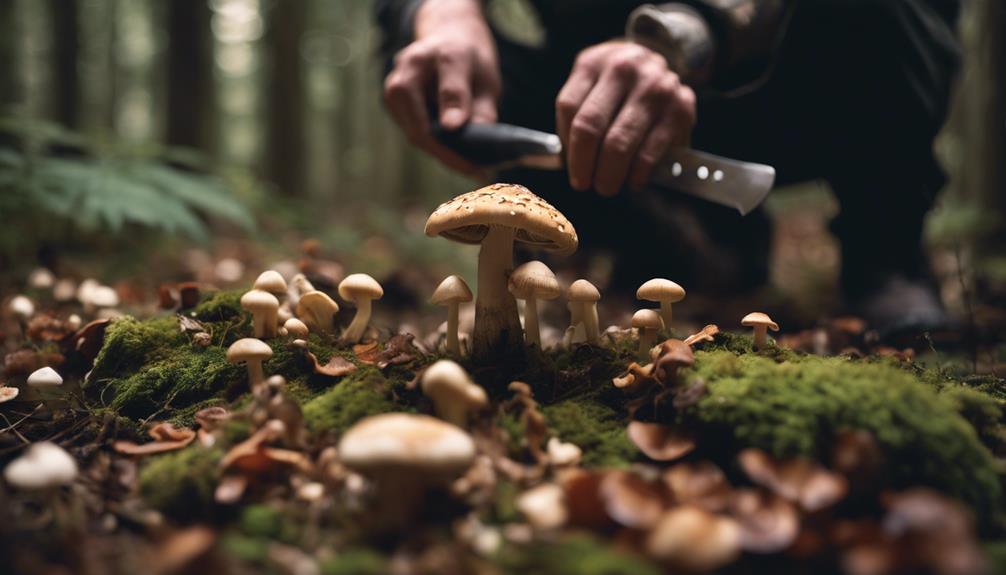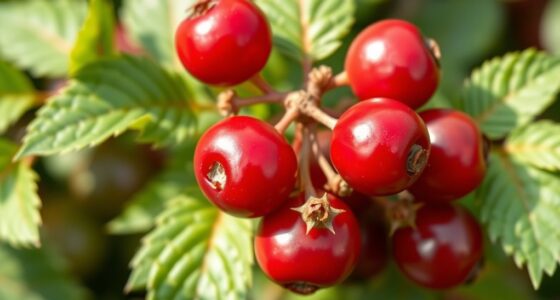In order to become proficient at mushroom foraging, it is essential to make safety and accurate identification a top priority. Seek guidance from experts, pay attention to lighting and sensory signals, and utilize reliable reference materials. Make sure you have the necessary tools such as a sharp knife, containers, and gloves. Learn to recognize toxic varieties and store mushrooms correctly. Experiment with cooking dishes like Morel Risotto and learn about advanced foraging techniques to diversify your skills. Join mushroom communities to gain valuable information and connections. Embarking on a journey into the world of mushroom hunting guarantees thrilling discoveries and new culinary experiences that will enhance your knowledge and abilities.
Key Takeaways
- Join local foraging communities for guidance.
- Practice precise mushroom identification.
- Utilize field guides and online resources.
- Learn from experienced foragers.
- Prioritize safety and caution in harvesting.
Safety Precautions
Prioritize safety by always verifying the identification of mushrooms before consumption to prevent potential toxicity risks. Accurate mushroom identification is vital to guarantee a safe foraging experience. Learning from experienced foragers in person can provide valuable insights into mushroom identification and enhance safety precautions.
Pay close attention to lighting conditions and other sensory details when foraging for mushrooms, as these can assist in proper identification.
Utilizing a quick-reference chart outlining mushroom habitats and seasons can further enhance safety measures while hunting. This tool can help you make informed decisions about which mushrooms to collect and which to avoid.
Dispelling myths about mushroom foraging is essential in understanding the potential risks involved. Additionally, learning about essential tools like spore prints can contribute to a safer and more enjoyable foraging experience.
Essential Foraging Tools

Guarantee a successful mushroom foraging experience by equipping yourself with essential tools such as a sharp knife, baskets, field guide, protective gloves, and sturdy footwear. These items are vital for enhancing your safety, efficiency, and overall enjoyment while out in the field.
Here are three key reasons why these foraging tools are indispensable:
- Harvesting Tool: A sharp knife is necessary for cleanly cutting mushrooms from their base without damaging the delicate fungi. It helps secure a clean harvest and prevents unnecessary harm to the mushroom patches.
- Collection Container: Baskets or mesh bags allow for proper air circulation, preventing mushrooms from getting soggy and deteriorating quickly. They also make it easy to carry your finds without crushing them.
- Reference Material: A field guide or identification app is like having a knowledgeable companion by your side, providing crucial information on mushroom characteristics, habitats, and potential look-alikes. Use these resources to make informed decisions while foraging.
Proper Mushroom Identification

Equip yourself with the necessary knowledge and resources to accurately identify various mushroom species for a safe foraging experience. Proper mushroom identification is essential to distinguish between edible mushrooms and toxic varieties.
To achieve this, consult field guides, online resources, and seek advice from experienced foragers. When identifying mushrooms, focus on key features such as cap shape, gill structure, stem characteristics, spore color, and habitat.
Understanding the differences between toxic look-alikes and common edible mushrooms is vital for making informed decisions. Take your time to carefully observe and study mushrooms before harvesting or consuming them. Remember that misidentifying mushrooms can have serious consequences, so always err on the side of caution.
Understanding Toxicity Levels

To guarantee your safety while foraging for mushrooms, understanding the varying toxicity levels among different mushroom species is paramount.
Here are three essential points to keep in mind:
- Importance of Poisoning Severity: Some toxic mushrooms can lead to severe illness or even death if consumed. Symptoms of mushroom poisoning can range from mild gastrointestinal issues to life-threatening organ failure. It's vital to be aware of the potential dangers posed by toxic mushrooms to avoid serious health consequences.
- Variability in Toxicity: Toxicity levels vary among mushroom species, with some being mildly poisonous while others are highly toxic. Proper identification of mushrooms is essential to differentiate between edible and toxic varieties. Inexperienced foragers should exercise caution and seek guidance from experts to prevent accidental ingestion of toxic mushrooms.
- Expert Guidance: Inexperienced foragers should never consume wild mushrooms without expert guidance. Consulting with experienced foragers or mycologists can help make sure that you steer clear of toxic varieties and enjoy the bounty of the forest safely during your foraging adventures.
Best Practices for Preservation

When preserving mushrooms, remember that drying and freezing are key techniques.
Drying mushrooms is a popular method to prolong their shelf life and lock in flavors, while freezing them after blanching helps maintain their freshness and taste for future culinary creations.
Proper Drying Techniques
For ideal preservation of mushrooms, mastering proper drying techniques is crucial to maintain their flavor and nutrients for long-term storage.
To make sure you're preserving your edible fungi correctly, follow these tips:
- Choose the Right Method: Whether you opt for a dehydrator, oven, or air-drying, make sure to select a technique that suits your preferences and equipment availability.
- Low and Slow: When drying mushrooms, keep the temperature low to preserve their delicate flavors and nutrients. Slow dehydration helps extend the shelf life of your harvest.
- Proper Storage: Once your mushrooms are dried to perfection, store them in airtight containers in a cool, dark place. This will help preserve their quality and flavor for an extended period.
Freezing for Freshness
Preserving mushrooms by freezing is an effective method to maintain their freshness and flavor for future culinary endeavors. When you freeze mushrooms properly, you can lock in their natural goodness, guaranteeing they are ready to elevate your dishes whenever you need them. Quick freezing mushrooms is key to preserving their texture and taste, making them a versatile ingredient for a wide range of recipes. Remember to clean and slice the mushrooms before freezing to streamline your cooking process later on. Store the frozen mushrooms in airtight containers or freezer bags to shield them from freezer burn and uphold their quality. The convenience of frozen mushrooms allows you to add them directly to dishes like soups, stews, and stir-fries without the hassle of thawing. Check out the table below for a quick reference on freezing mushrooms effectively:
| Freezing Mushrooms | Best Practices |
|---|---|
| Quick freeze | Retains texture |
| Clean before freeze | Ensures readiness |
| Store airtight | Prevents freezer burn |
Cooking Tips and Recipes

When it comes to cooking morel mushrooms, there are various flavorful dishes you can create using different culinary techniques. From sautéing to pickling, morels can elevate the taste of soups, stews, risottos, and pasta dishes.
Foraging for these savory mushrooms opens up a world of possibilities for delicious recipes that highlight their meaty texture and rich, nutty flavor.
Flavorful Mushroom Dishes
Enhance your culinary repertoire with these mouthwatering mushroom dishes that will elevate your cooking game to the next level.
- Sautéed Morel Mushrooms: Indulge in the earthy flavors of Morel mushrooms by sautéing them with butter and garlic. The simplicity of this dish allows the unique taste of Morel mushrooms to shine through, creating a delightful culinary experience.
- Chanterelle Risotto: Elevate your risottos and pasta dishes with the rich, nutty flavor of Chanterelle mushrooms. Their distinct taste adds depth and complexity to these dishes, making them a crowd-pleaser for any occasion.
- Grilled Oyster Mushrooms: Transform Oyster mushrooms into a savory side dish by grilling them with olive oil and herbs. The grilling process enhances their natural flavors, resulting in a delicious and satisfying addition to your meal.
These flavorful mushroom dishes showcase the versatility and unique characteristics of Morel and Chanterelle mushrooms, providing a culinary experience that's both delicious and memorable.
Culinary Techniques Foraging
Exploring diverse culinary techniques foraging for mushrooms can elevate your cooking skills and expand your flavor palette. When it comes to mushrooms growing in the wild, such as morels, good ID is important to make sure you're harvesting safe and delectable varieties.
Morels, with their meaty texture and nutty flavor, are a culinary delight that can be enjoyed in various ways. To make the most of these treasures, it's vital to thoroughly cook morels to avoid any risks of poisoning. When cleaning morels, opt for a soft brush instead of washing them to preserve their delicate texture.
Sautéing morels is a popular method, but they can also be added to a wide array of dishes or dried for long-term storage. Keep in mind that different types of morels, like black, white, and yellow morels, offer unique flavors and culinary possibilities for you to explore in your kitchen.
Savory Mushroom Recipes
To elevate your culinary skills with mushrooms, try out these savory mushroom recipes that will tantalize your taste buds.
- Morel Mushroom Risotto
- Sauté sliced morel mushrooms in butter until golden brown.
- Add Arborio rice and gradually stir in mushroom broth until creamy.
- Finish with Parmesan cheese, fresh herbs, and a squeeze of lemon for a luxurious dish.
- Stuffed Shiitake Mushrooms
- Remove stems from shiitake caps and chop them finely.
- Mix chopped stems with cream cheese, garlic, and breadcrumbs.
- Stuff the mixture into the mushroom caps, bake until golden, and enjoy a savory appetizer.
- Portobello Mushroom Burgers
- Marinate portobello caps in balsamic vinegar, garlic, and olive oil.
- Grill until tender and serve on a toasted bun with lettuce, tomato, and your favorite toppings for a satisfying meaty alternative.
These recipes showcase the versatility of edible mushroom species and their ability to enhance a wide range of dishes with their unique flavors and textures.
Advanced Foraging Techniques

To master advanced foraging techniques, focus on individual mushroom identification rather than relying on general rules. In North America, different species like the Saffron Milky Cap or King Bolete require a nuanced approach for accurate recognition. Experienced foragers emphasize the importance of studying each mushroom's unique characteristics, such as cap shape, gill attachment, spore print color, and scent. By honing your observation skills and delving into the specific traits of various mushrooms, you can enhance your ability to differentiate between closely related species.
Advanced foraging also involves seeking guidance from local mushroom clubs and experienced foragers. Joining these communities can provide valuable insights into rare or lesser-known species, as well as practical tips for locating them in the wild. Additionally, utilizing resources like books, online forums, and expert advice can further expand your knowledge base and refine your foraging skills.
Joining Mushroom Foraging Communities

Consider joining mushroom foraging communities to enhance your knowledge and skills in mushroom hunting. These communities offer a wealth of benefits that can elevate your foraging experience:
- Access to Experienced Foragers: By joining mushroom foraging communities, you can tap into the expertise of seasoned foragers who can provide valuable insights, tips, and guidance to help you improve your foraging skills.
- Organized Group Activities: Many mushroom foraging communities organize group foraging trips, workshops, and events that allow you to learn hands-on in the field, enhancing your practical knowledge of mushroom hunting techniques.
- Networking Opportunities: Connecting with fellow mushroom enthusiasts through online forums or local clubs can help you build a network for sharing knowledge, resources, and experiences, fostering a supportive community of like-minded individuals passionate about fungi.
Engaging with these communities can broaden your understanding of different mushroom species, improve your foraging practices, and contribute to conservation efforts in the fascinating world of mushroom hunting.
Frequently Asked Questions
What Is the Trick to Finding the Mushroom?
The trick to finding the mushroom? Look in moist, shady spots on north-facing slopes near trees like beech or oak. Understand terms like cap, gills, and stalk. Carry a compass for safety. Join local clubs for insights.
How to Mushroom Hunt for Beginners?
To mushroom hunt for beginners, start by exploring different habitats and seasons. Learn identification basics from experts or reliable sources. Carry essential gear for safety. Remember, 90% of mushroom poisoning cases result from misidentification.
Do Morels Pop up Overnight?
Morels do not pop up overnight; they typically take several days to grow to a noticeable size. Their growth depends on factors like temperature, moisture, and soil composition. Checking potential hunting spots regularly is essential.
What Are the Best Conditions for Mushroom Hunting?
When hunting mushrooms, the best conditions involve dampness, shade, and specific tree hosts like beech or oak. Remember, not all mushrooms are safe to eat, so proper identification is essential. Happy foraging!
Conclusion
To wrap up, mushroom foraging can be a rewarding and enjoyable hobby when done safely and responsibly. By following the tips and techniques shared by seasoned professionals, you can enhance your skills and knowledge in the world of fungi.
Remember, always prioritize safety, proper identification, and preservation methods to guarantee a successful and fulfilling foraging experience. And if you're hesitant to start, just remember that every expert was once a beginner too.
Happy hunting!









